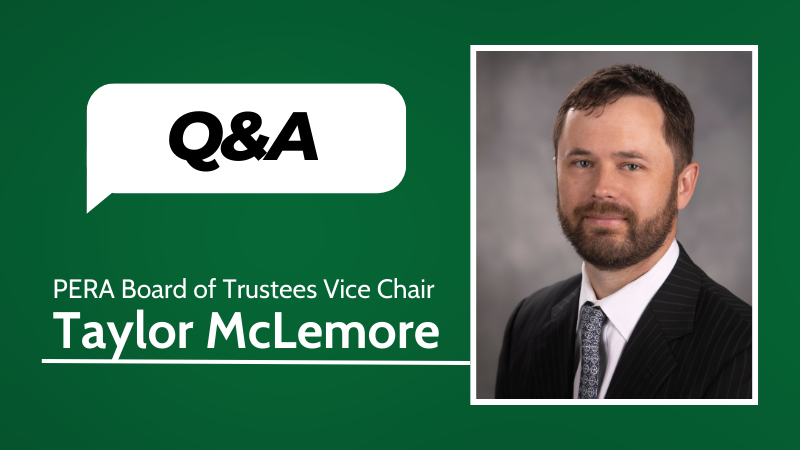With over $45 billion in assets, the Investment team at Colorado PERA, guided by the PERA Board of Trustees’ investment policies, seeks the highest investment return for an appropriate level of risk. The team pursues this goal through a well-diversified portfolio of assets, where diversification helps to smooth the returns to the Fund. In order to foster this diversity, the Fund assets are divided into five asset classes: Public Equity, Fixed Income, Private Equity, Real Estate, and the Opportunity Fund. Today, we will discuss the Public Equity asset class.
Public Equity, or Equity, is PERA’s largest investment asset class. with over $26 billion under management (as of April 28, 2017). This accounts for 57.6 percent of total Fund assets, within the 47 percent to 59 percent asset allocation range established by PERA’s Board. Such a significant allocation requires the Equities team, under the direction of the Director of Equities, to manage a diversified group of stocks in order to limit the risk of any one holding, while earning the long-term financial reward for holding stocks.
The Equities team achieves this diversified investment return in two ways: by the selection of the equity benchmark and through the employment of varied investment strategies. First, the benchmark for PERA Equities, selected by PERA’s Board, is the MSCI All Country World Investable Market Index (ACWI IMI). This index includes thousands of stocks across the globe, covers various sectors and industries, and encompasses companies of all sizes (large, medium, and small). The “All Country” nature of the index means that the index includes stocks from both developed economies, like the U.S. and Western Europe, and emerging economies, like Eastern Europe, China, and Brazil. As such, this diversified benchmark covers the broad spectrum of the global equity market.
With a diversified benchmark established for Equities, the structure of the Equities portfolio takes advantage of this broad stock universe to achieve a strong return with reasonable risk. The Equities team employs a combination for active strategies, which attempt to exceed benchmark returns, and passive strategies, which seek to provide benchmark returns. This blend can be considered a “core/satellite” approach, where the core passive index return is augmented by the satellite active management returns.
To execute this approach, the Equities Division employs 15 people, led by the Director. The 14 investment professionals on the team have earned the right to use the Chartered Financial Analyst (CFA) designation, and eight of the 14 have advanced degrees. The average investment experience of the team members is 15 years, making this a very experienced group of portfolio managers, analysts, and traders.
On the internal active management side, representing about 35 percent of PERA Equity assets, 12 portfolio managers and analysts manage five separate portfolios. These portfolios cover various regions and sizes of the equity market (for example, U.S., global, large, and small cap). Each portfolio is managed by a three-person portfolio manager team. The multiple portfolio manager structure allows for a more balanced point-of-view, as well as improved succession planning. At the analyst level, each analyst covers one or more global sectors, potentially contributing investment ideas to any of the five active portfolios.
These investment ideas consist of the purchase of stocks deemed attractive by the analyst, based on the fundamental analysis of the issuing company’s potential, and the sale of those considered less attractive. While the analysts present the investment ideas, the portfolio management teams decide whether the idea is appropriate for a given portfolio. In this vein, the portfolio managers assess how a new stock position will affect the risk of the portfolio, in addition to the sector, industry, and country exposures. Each portfolio has a designated benchmark index and active risk target, which indicates how far a portfolio can diverge from its benchmark, and the portfolio managers take this active risk into account when considering an analyst’s investment ideas.
Another 35 percent of the Equities group assets are managed internally, but on a passive basis. This means that the portfolios are managed with an eye toward meeting, not beating, the designated benchmark’s returns. At PERA, two passive portfolio managers manage three accounts, which cover U.S. and non-U.S. Developed markets across all market capitalization segments. Using sophisticated quantitative tools and techniques, while adhering to various risk constraints and holdings restrictions, these portfolio managers strive to match the benchmark index return while keeping transaction costs to a minimum.
With 70 percent of the Equity assets managed internally by staff, PERA’s preference for internal management is quite clear. Given the economies of scale associated with the amount PERA manages internally, the Equities team can provide both active and passive management at a lower cost than the external alternatives. PERA has access to top investment talent, providing all of its portfolios the chance to meet their objectives, whether active or passive. PERA also has an experienced trading team, which doubles as the passive portfolio management team, to execute all its equity and currency trades.
PERA Equities has several competitive advantages, contributing to its long-term success. PERA’s low-cost internal management advantage, due to economies of scale and direct access to investment talent, has already been highlighted. PERA also benefits from its perpetual investment time horizon, allowing PERA investment professionals to capitalize on market dislocations as patient capital, potentially providing liquidity to other market participants with shorter investment time horizons. This longer-term perspective fosters a low-turnover approach, which not only lowers transaction costs, but also allows PERA’s investment managers to develop medium- to long-term views on companies they anticipate to be winners, rather than react to short-term “noise.”
In addition, PERA and its Equities staff recognize the benefit of employing some external managers. External managers offer unique perspectives and often utilize different strategies than employed in PERA’s internal portfolio management process, thus offering the opportunity to diversify the return to the overall Equity asset class. Beyond the actual returns provided by these active managers, PERA’s Equities team can leverage these managers’ expertise and company contacts for idea generation, investment theme discussion, and portfolio risk considerations. This is a significant information advantage that PERA can use as both an investment manager and client. That said, external management comes at a cost, and the Equities team uses larger mandates to lower fees (because external managers offer lower fees to larger clients), thus accessing external expertise at a reasonable expense.
The Equities team utilizes all the tools at its disposal to form a low cost and well-diversified portfolio of stocks that outperforms the benchmark on a risk-adjusted basis over long time periods. With broad access to investment acumen, both internally and externally, the PERA Equities team is well suited to meet it strategic objective. This objective, to manage public equities to meet or exceed benchmark performance while adhering to investment guidelines and risk parameters, is designed to help the overall PERA Fund deliver the necessary investment results for its members.
Useful links to details on the PERA investment program:
Investment Frequently Asked Questions
Colorado PERA Statement of Investment Policy
Global equityA type of investment that includes publicly traded stocks in companies based in the United States and abroad.Asset classesA category of similar investments. Common asset classes include global equity (such as publicly traded stocks), real estate, and cash.LiquidityThe ease with which an asset can be converted to cash without a significant loss of value.AlternativesA broad category of investments that don’t fit into traditional categories like stocks and bonds.Total fundThe combined assets of all PERA Defined Benefit Plan trust funds (division trust funds, health care trust funds, and life insurance reserve) across all asset classes.Asset allocationAn investor’s mix of stocks, bonds, and other investments. PERA’s strategic asset allocation is set by the PERA Board of Trustees.Public equityA type of investment in which investors purchase shares of a company that is traded on a public stock exchange.Private equityA type of investment in which investors purchase shares of a company that is not traded on a public stock exchange.Fixed incomeA type of investment that pays investors a fixed rate of interest over a set period of time. Bonds are a common type of fixed income investment.BenchmarkA tool used to measure performance. For example, an investor can use a stock index as a benchmark to measure his/her own investment performance compared to the market as a whole.Asset classA category of similar investments. Common asset classes include global equity (such as publicly traded stocks), real estate, and cash.Asset classA category of similar investments. Common asset classes include global equity (such as publicly traded stocks), real estate, and cash.Asset classA category of similar investments. Common asset classes include global equity (such as publicly traded stocks), real estate, and cash.




